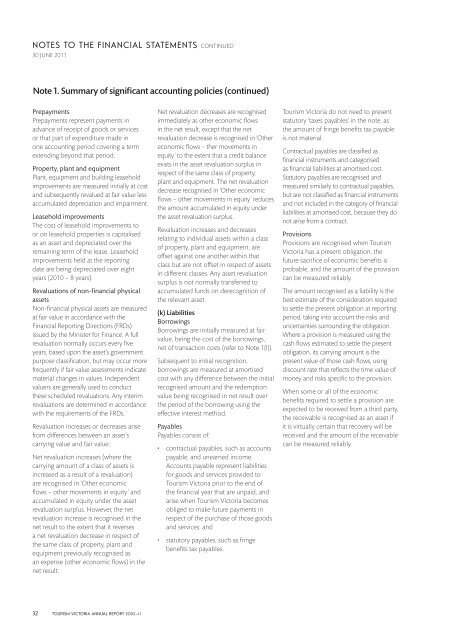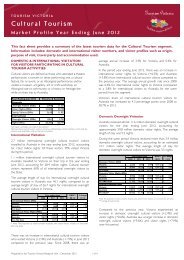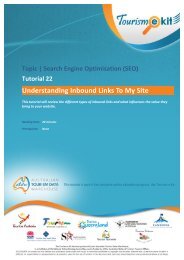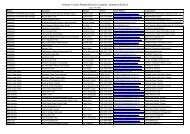Annual Report 2010–2011, Part 2: Financial (1.8 ... - Tourism Victoria
Annual Report 2010–2011, Part 2: Financial (1.8 ... - Tourism Victoria
Annual Report 2010–2011, Part 2: Financial (1.8 ... - Tourism Victoria
You also want an ePaper? Increase the reach of your titles
YUMPU automatically turns print PDFs into web optimized ePapers that Google loves.
NOTES TO THE FINANCIAL STATEMENTS CONTINUED<br />
30 JUNE 2011<br />
Note 1. Summary of significant accounting policies (continued)<br />
Prepayments<br />
Prepayments represent payments in<br />
advance of receipt of goods or services<br />
or that part of expenditure made in<br />
one accounting period covering a term<br />
extending beyond that period.<br />
Property, plant and equipment<br />
Plant, equipment and building leasehold<br />
improvements are measured initially at cost<br />
and subsequently revalued at fair value less<br />
accumulated depreciation and impairment.<br />
Leasehold improvements<br />
The cost of leasehold improvements to<br />
or on leasehold properties is capitalised<br />
as an asset and depreciated over the<br />
remaining term of the lease. Leasehold<br />
improvements held at the reporting<br />
date are being depreciated over eight<br />
years (2010 – 8 years).<br />
Revaluations of non-financial physical<br />
assets<br />
Non-financial physical assets are measured<br />
at fair value in accordance with the<br />
<strong>Financial</strong> <strong>Report</strong>ing Directions (FRDs)<br />
issued by the Minister for Finance. A full<br />
revaluation normally occurs every five<br />
years, based upon the asset’s government<br />
purpose classification, but may occur more<br />
frequently if fair value assessments indicate<br />
material changes in values. Independent<br />
valuers are generally used to conduct<br />
these scheduled revaluations. Any interim<br />
revaluations are determined in accordance<br />
with the requirements of the FRDs.<br />
Revaluation increases or decreases arise<br />
from differences between an asset’s<br />
carrying value and fair value.<br />
Net revaluation increases (where the<br />
carrying amount of a class of assets is<br />
increased as a result of a revaluation)<br />
are recognised in ‘Other economic<br />
flows – other movements in equity’ and<br />
accumulated in equity under the asset<br />
revaluation surplus. However, the net<br />
revaluation increase is recognised in the<br />
net result to the extent that it reverses<br />
a net revaluation decrease in respect of<br />
the same class of property, plant and<br />
equipment previously recognised as<br />
an expense (other economic flows) in the<br />
net result.<br />
Net revaluation decreases are recognised<br />
immediately as other economic flows<br />
in the net result, except that the net<br />
revaluation decrease is recognised in ‘Other<br />
economic flows – ther movements in<br />
equity’ to the extent that a credit balance<br />
exists in the asset revaluation surplus in<br />
respect of the same class of property,<br />
plant and equipment. The net revaluation<br />
decrease recognised in ‘Other economic<br />
flows – other movements in equity’ reduces<br />
the amount accumulated in equity under<br />
the asset revaluation surplus.<br />
Revaluation increases and decreases<br />
relating to individual assets within a class<br />
of property, plant and equipment, are<br />
offset against one another within that<br />
class but are not offset in respect of assets<br />
in different classes. Any asset revaluation<br />
surplus is not normally transferred to<br />
accumulated funds on derecognition of<br />
the relevant asset.<br />
(k) Liabilities<br />
Borrowings<br />
Borrowings are initially measured at fair<br />
value, being the cost of the borrowings,<br />
net of transaction costs (refer to Note 1(l)).<br />
Subsequent to initial recognition,<br />
borrowings are measured at amortised<br />
cost with any difference between the initial<br />
recognised amount and the redemption<br />
value being recognised in net result over<br />
the period of the borrowing using the<br />
effective interest method.<br />
Payables<br />
Payables consist of:<br />
• contractual payables, such as accounts<br />
payable, and unearned income.<br />
Accounts payable represent liabilities<br />
for goods and services provided to<br />
<strong>Tourism</strong> <strong>Victoria</strong> prior to the end of<br />
the financial year that are unpaid, and<br />
arise when <strong>Tourism</strong> <strong>Victoria</strong> becomes<br />
obliged to make future payments in<br />
respect of the purchase of those goods<br />
and services; and<br />
• statutory payables, such as fringe<br />
benefits tax payables.<br />
<strong>Tourism</strong> <strong>Victoria</strong> do not need to present<br />
statutory ‘taxes payables’ in the note, as<br />
the amount of fringe benefits tax payable<br />
is not material.<br />
Contractual payables are classified as<br />
financial instruments and categorised<br />
as financial liabilities at amortised cost.<br />
Statutory payables are recognised and<br />
measured similarly to contractual payables,<br />
but are not classified as financial instruments<br />
and not included in the category of financial<br />
liabilities at amortised cost, because they do<br />
not arise from a contract.<br />
Provisions<br />
Provisions are recognised when <strong>Tourism</strong><br />
<strong>Victoria</strong> has a present obligation, the<br />
future sacrifice of economic benefits is<br />
probable, and the amount of the provision<br />
can be measured reliably.<br />
The amount recognised as a liability is the<br />
best estimate of the consideration required<br />
to settle the present obligation at reporting<br />
period, taking into account the risks and<br />
uncertainties surrounding the obligation.<br />
Where a provision is measured using the<br />
cash flows estimated to settle the present<br />
obligation, its carrying amount is the<br />
present value of those cash flows, using<br />
discount rate that reflects the time value of<br />
money and risks specific to the provision.<br />
When some or all of the economic<br />
benefits required to settle a provision are<br />
expected to be received from a third party,<br />
the receivable is recognised as an asset if<br />
it is virtually certain that recovery will be<br />
received and the amount of the receivable<br />
can be measured reliably.<br />
32 TOURISM VICTORIA ANNUAL REPORT 2010–11
















